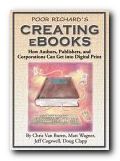complete guide to e-book publishing – on a budget
Creating eBooks offers distinct advantages to writers. You can publish whatever you wish; it doesn’t cost much; you can start small; there are no printing, storage, or postage costs; and you can control the whole process from your back bedroom. It’s true that there are also problems of which format to choose and what to do about copying, but technical solutions to these problems are emerging rapidly. Chris Van Buren and Jeff Cogswell address all these issues, and provide you with all the information you need to make a start.
 They include a survey of the e-publishing business; planning and creating an e-book; getting the book published; finance and copyright; and a selection of personal success stories. The variety of e-book readers and file formats is explored fully, giving a reasonably even-handed account of the advantages and drawbacks of each one. They cover GlassBook, Acrobat, Rocketbook, and Softbook, as well as Microsoft’s Reader which has caught up after a late start.
They include a survey of the e-publishing business; planning and creating an e-book; getting the book published; finance and copyright; and a selection of personal success stories. The variety of e-book readers and file formats is explored fully, giving a reasonably even-handed account of the advantages and drawbacks of each one. They cover GlassBook, Acrobat, Rocketbook, and Softbook, as well as Microsoft’s Reader which has caught up after a late start.
They also discuss print on demand (POD) in a lot of detail, pointing out that some authors even give away their e-books, calculating that it will create a demand for sales of the print version. En passant they point out that despite all the obvious novelties in e-books, the most commercially successful business models are those which are gradually merging with traditional book publishing.
They also give a detailed account of how the new e-publishing industry works, and how important it is for authors and publishers to know about such things as digital object identifiers (DOI) and meta-data descriptions. The importance of XML becomes apparent at this point. Describing data in a general, universal language makes it more useable, re-useable, and transferable from one form to another.
Why is XML important? Because this is the manner in which electronic books will be described in the future. The truth is that writing e-books is relatively easy. This part of the process involves skills many people already possess. It’s the promotion and marketing of them which is difficult – and will be new to most folk.
They describe all the options and methods of copyright, encryption-protection, and digital rights – then they suggest that we wait and see. Their argument is that we are more frightened of people swapping free copies than we need to be.
One of the more interesting features of the advice they give is that it’s suitable either for individuals with just one book to market, or for people who might wish to set up as publishers, ready to promote several titles (which they argue can be done almost as easily as one).
You will also learn a lot about the economics and business practices of the traditional book publishing trade – on which so much of the e-book world is based. There are also in-depth tutorials on copyright and the small print of writer-publisher contracts.
As usual with the excellent Topfloor ‘Poor Richard’ series, every chapter is packed with recommendations for online resources – many of which are low-budget or free.
There’s also a useful list of e-book publishers and the literary genres they handle. Anybody who is interested in the e-book phenomenon – whether as writer, publisher, or both – needs to understand the issues discussed here.
© Roy Johnson 2002
Chris Van Buren and Jeff Cogswell, Poor Richard’s Creating E-Books, Lakewood (CO): Topfloor Publishing, 2001, pp.317, ISBN: 1930082029
More on eCommerce
More on media
More on publishing
More on technology